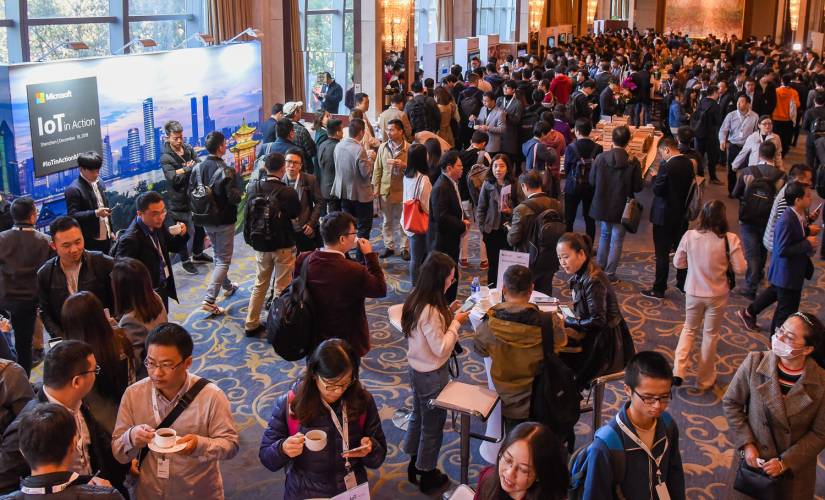Space is limited – make sure you reserve your spot for the IoT in Action event in Santa Clara on October 10th! Register for free today!
The Internet of Things (IoT), together with a series of catalytic technology such as cloud, edge computing, artificial intelligence (AI) and mixed reality, is creating billions of connected endpoints for businesses to optimize operational efficiency, improve workplace safety and increase revenue.
With such benefits, it’s unsurprising that we see 88 percent of business reporting that IoT is very or somewhat critical to their success, according to the recent Microsoft IoT Signals report. And not only are companies increasingly recognizing the contributions IoT has on their success as a business, but IoT is also being adopted across industries: retail, manufacturing, agriculture, healthcare – the list goes on.
In fact, the report shows that 85 percent of decision makers from enterprise organizations have adopted IoT, and 74 percent have projects in the “use” phase. Which leads us to the question here: as the IoT market continues to grow and mature, what new opportunities and challenges are emerging that should be top of mind?
We polled some Microsoft partner during recent IoT in Action events about their key takeaways on building, implementing or selling new IoT solutions and experiences – below are their thoughts ranging from what it means to be successful to partnering on going to market.
IoT Success Revolves Around Simplicity & Security
Finding success with IoT – whether you’re working on developing a solution or implementing it into your business operations – often hinges on these questions: is it simple, and is it secure?
During our conversations with partners we heard the same theme over and over: IoT needs to be simple from the edge to the cloud. Speaking of their IT buyer clients, Travis Gerber, CEO of Buddy Platform said, “Customers often tell us they are looking for solutions that are both simple and secure. This looks slightly different for everyone. For us, that means translating complex building data into meaningful insights they can take action on.”
The research agrees. The IoT Signals report also found that one of the top IoT barriers was challenges stemming from complexity and technical aspects. In fact, 39 percent of responders said this was their biggest barrier to IoT adoption.
To assist companies with overcoming this challenge, Microsoft has focused on finding ways to make it easier to build and use IoT solutions, such as the release of IoT Plug and Play, which offers a new, open modeling language to seamlessly connect IoT devices to the cloud. Now developers can quickly connect IoT devices to the cloud, as well as build smarter solutions that just work with the cloud, all without having to write a single line of embedded code. Plus, by using Azure IoT Central or Azure IoT Hub, businesses can prototype and build larger scale IoT deployments in significantly less time.
Security Should be an End-to-End Process
We also found that while Microsoft partners place a high value on security when building IoT solutions, security is rarely a barrier to IoT adoption. And the IoT Signals numbers back this up with only 19 percent of companies listing security as their biggest barrier to adoption – even though 97 percent of companies said they were concerned about security when adopting IoT.
Yet with billions of new devices being connected, organizations still need to secure them to protect data, privacy, physical safety, and infrastructure. So how should companies be thinking about IoT security?
The first step is looking at how you can simplify the complexity of your IoT security solution with built-in protection at each stage of your deployment – including cloud services and devices – and minimizing security weaknesses wherever they exist. Building security into every part of your IoT platform is essential for minimizing risks to your private data, business assets and reputation.
Microsoft has been successful in thinking about security from an end-to-end perspective – and even more importantly – has been successful in helping their partners and customers do the same. Azure Sphere, for instance, is a comprehensive IoT solution that includes hardware, OS, and cloud components so partners can securely connect existing equipment as well as build and roll out new, connected IoT devices.
And securely connecting existing equipment is a big piece for companies that were early adopters of IoT solutions. By using the guardian module with Azure Sphere, for instance, companies have the ability to enable secure cloud-connectivity on existing equipment. This in turn, helps unlock new customer experiences, new business models, and improved operational efficiency.
You Need More Than Data: Actionable, Real-Time Insights Matter
IoT solutions only solve challenges if customers can manage the data and obtain pertinent insights. Even more importantly, partners told us that the insights must be based on real-time data and presented in an actionable format to customers.
One such partner, Zencity, uses Microsoft services and platforms to provide real-time insights to its customers, which are local governments that must make quick decisions that could affect the safety and wellbeing of their citizens. “We use a lot of Azure’s more advanced capabilities around AI to build the processing that we need to analyze millions and millions of data points from all of these different feedback sources and turn them in real time into insights for CD leaders,” says Eyal Feder-Levy, CEO of Zencity.
Microsoft is also focused on providing companies with the tools and resources they need to turn data into actionable insights. Those attending the Santa Clara IoT in Action event will have a chance to join Microsoft experts on October 9 for a full day of hands-on technical training that explores how you can use Windows for IoT and Azure IoT to power more intelligent solutions.
Collaboration is Critical for Accelerating Time to Market
Partners also stressed the importance of having a short development time so they could quickly get to market ahead of competitors and capture market share. But they also needed to do so without compromising quality and security, as well as come up with effective marketing and sales messaging – all of which can take up precious time.
During the Microsoft IoT in Action events, many partners shared how by collaborating with Microsoft and their IoT ecosystem, they were able to surface valuable IoT build-with and co-sell opportunities. Additionally, by using the first- and third-party accelerators designed for Microsoft Azure, as well as Microsoft programs and resources, companies can leverage already existing building blocks and fast track their next IoT project.
“One of the great things that we’re seeing that Microsoft is doing is with its solution accelerators, really helping our customers and ISPs that are partnered with Cradlepoint bring that solution to market much faster,” said Tony Puopolo, VP of North America Channel Sales & Alliances at Cradlepoint.
IoT in Action: Connecting Technology and People
IoT solutions aren’t just about the technology – it comes down to people. At the core, IoT solves people’s problems and challenges. And successfully developing or implementing those solutions requires relationships with people: partners, vendors, device makers.
Join us for an upcoming IoT in Action event in Santa Clara, CA (October 10) or Warsaw, Poland (November 13) to start building future business partnerships, optimizing efficiencies, and maximizing revenue opportunity.
For additional insights into how other companies are developing and deploying IoT technology across industries, watch our short, actionable IoT in Action webinars.





